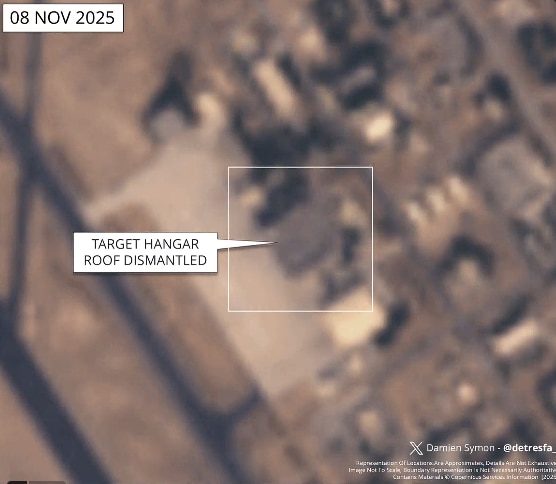
More than six months after the brief but intense four-day conflict between India and Pakistan, Islamabad’s restoration efforts at several damaged military sites continue to move at a painfully slow pace. Fresh satellite imagery reviewed and shared by renowned OSINT (Open Source Intelligence) analyst Damien Symon suggests that Pakistan has yet to recover from the deep structural blows delivered by the Indian military during Operation Sindoor.
Symon, who earlier revealed that India had struck Pakistan’s sensitive nuclear weapons depot at the Kirana Hills complex, has now pointed to ongoing reconstruction work at multiple high-value locations—highlighting the lasting impact of India’s precision strikes.
Satellite Imagery Shows Pakistan Still Rebuilding Airbases
According to Symon’s latest assessment, Pakistan has begun constructing a new facility at the Nur Khan Airbase in Rawalpindi, one of the most critical locations targeted by Indian forces. The airbase falls close to the Strategic Plans Division headquarters, the body responsible for overseeing Pakistan’s nuclear Arsenal.
Sharing updates on X (formerly Twitter) on November 16, Symon stated: “Pakistan seems to have built a new facility at Nur Khan Airbase, at the location India targeted during its May 2025 conflict.”
Similarly, at the Jacobabad Airbase in northern Sindh—another site hit during Indian strikes—restoration remains incomplete. Symon noted that the damaged hangar is still undergoing phased dismantling, likely to inspect internal structural damage before reconstruction can begin.

On November 15, Symon wrote: “Imagery over the past few months reveals the hangar targeted by India at Jacobabad Airbase has had its roof taken apart in stages—likely as internal damage checks continue before the structure is repaired.”
Key Pakistani Installations Hit by India: Current Status
During Operation Sindoor, India targeted at least ten Pakistani military installations following Pakistan’s attacks on Indian military and civilian areas. These included multiple Pakistan Air Force bases, critical infrastructure and sensitive military locations.
| Targeted Location | Region | Post-Strike Status (as per OSINT visuals) |
|---|---|---|
| Nur Khan Airbase | Rawalpindi | New facility under construction; major damage still being addressed. |
| Jacobabad Airbase | Northern Sindh | Hangar roof dismantled; internal damage under evaluation. |
| Murid Airbase | Punjab | Damage acknowledged; restoration status undisclosed. |
| Mushaf, Rafiqui & Bholari Bases | Punjab & Sindh | Reported strikes; limited restoration data available. |
| Sialkot & Sukkur Bases | Punjab & Sindh | Damage sustained; OSINT tracking ongoing. |
Wing Commander Vyomika Singh earlier stated that Pakistan suffered “very heavy” and “unsustainable losses” during India’s response, on both air and ground operations.
Pakistan’s Admission Confirms India’s Precision Strikes
The strategic significance of the Nur Khan Airbase strike became clearer when Pakistan’s Prime Minister Shehbaz Sharif publicly admitted that Indian missiles did hit key military facilities—including the Chaklala-based airbase—during Operation Sindoor. This reinforced earlier Indian claims that the strikes were precise, targeted and executed in retaliation to the Pakistan-backed Pahalgam terror attack in April.
India’s objective during the operation was to neutralise Pakistan’s capability to launch further attacks by degrading its air infrastructure and sensitive military assets.
OSINT Evidence Also Confirms Indian Strike at Kirana Hills
In July, Symon released Google Earth imagery suggesting visible impact marks at the Kirana Hills site—long believed to house Pakistan’s nuclear storage facilities. The satellite visuals, reportedly taken in June, closely aligned with reports of Indian precision strikes in May.
Known for his extensive work with publicly accessible satellite data, geo-location tools and conflict-mapping resources, Damien Symon has built a reputation for independently verifying or debunking claims in conflict zones, particularly across South Asia.
India’s Deep-Strike Capability on Display
Operation Sindoor demonstrated India’s ability to hit high-value military locations deep inside Pakistani territory. Using advanced precision-guided munitions, India targeted a total of 11 Pakistani military installations—significantly degrading their functionality and exposing vulnerabilities in Pakistan’s air defence network.
Despite Pakistan’s claims of “successful defence” during the conflict, the slow and visibly incomplete restoration efforts six months later highlight the depth of India’s strategic impact—a reality that OSINT evidence continues to reaffirm.
For breaking news and live news updates, like us on Facebook or follow us on Twitter and Instagram. Read more on Latest World on thefoxdaily.com.






COMMENTS 0